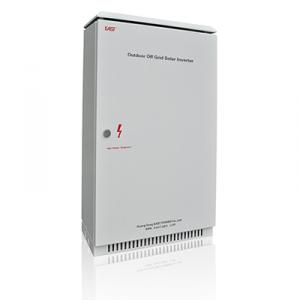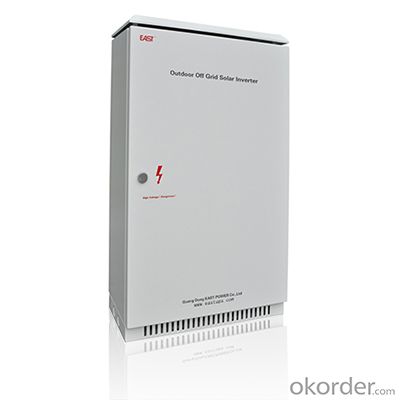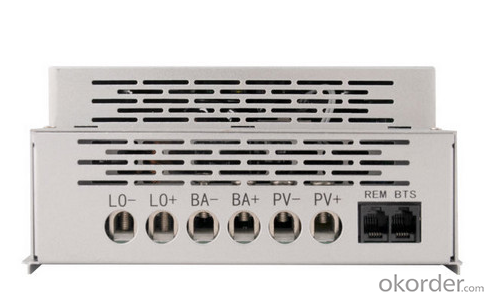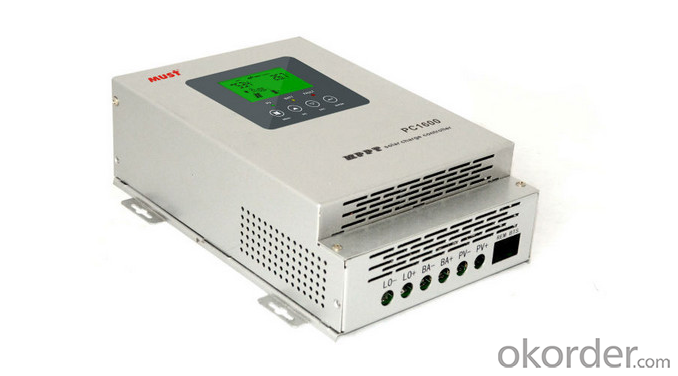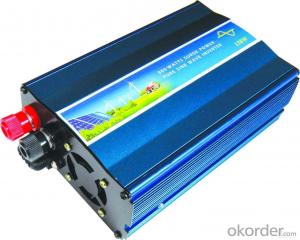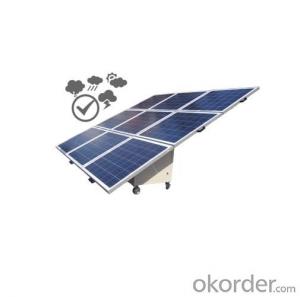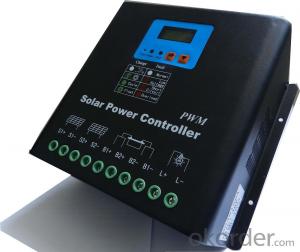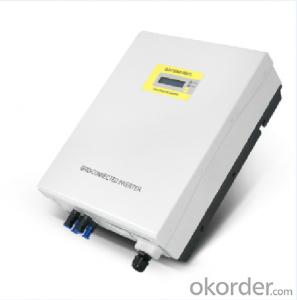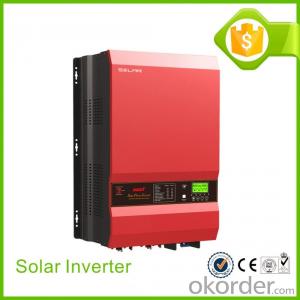5000W Outdoor Off-Grid Solar Inverter Specially Designed for Outdoor Communication Equipment
- Loading Port:
- China main port
- Payment Terms:
- TT or LC
- Min Order Qty:
- 1 pc
- Supply Capability:
- 1000 pc/month
OKorder Service Pledge
OKorder Financial Service
You Might Also Like
Outdoor Off-Grid Solar Inverter 500W-2000W
EA-GF outdoor series is specially designed for outdoor communication equipment, network equipment, traffic control systems; it is also for corner of the city, the countryside, and the mountains. The whole unit adopts high and low temperature resistance, corrosion resistance, dustproof, waterproof with multi-format mode, MPPT control, online regulation, short circuit protection, output frequency adaptable, output overload protection, battery charge management, monitoring, energy saving,environmental protection and other functions; This series of products can effectively ensure communication, network, traffic control equipment's power supply and operation stably, and be good partner of the outdoor communications equipment, network equipment, and traffic control systems.
● Special design for outdour use
● Multi-setting
※ Can adjust the use mode according to the configuration status and sun source status: PV priority or AC priority mode;
※ Can select the charging current based on the configured capacity of the battery.
● High reliability
※ Independent MPPT (Maximum Power Point Tracking) control microprocessor system
※ Independent inverter microprocessor control system
※ Many kinds of protection for overcharge, over-discharge, short-circuit, overload ect., and special PV reverse connection
protection as well
● Isolated and pure sine wave technology
● Advanced MPPT control system
● Intelligent charge management
● LED display mode
● Wide input range
● High-speed synchronous conversion
● Friendly alarm system
● Unattended and intelligent monitoring
● No-load off function (Option)
● Frequency auto sense
● Intelligent communication port (option)
Model | GF500-HW | GF1000-HW | GF1000-HW | GF1500-HW | GF2000-HW |
Power | 500W | 1000W | 1000W | 1500W | 2000W |
Battery Voltage | 24Vdc | 48Vdc | |||
Working Mode | PV(Photovoltaic priority) / AC (AC priority) Optional | ||||
PV | |||||
Input Voltage Range | 24Vdc – 45Vdc | 48Vdc – 90Vdc | |||
PV Panels Configuration (Suggestion) (vmp) | 30Vdc – 36Vdc | 60Vdc – 71Vdc | |||
PV Panels Configuration(Suggestion) (Imp≤rated current) | ≤40A | ≤60A | ≤40A | ≤60A | ≤80A |
Max Charge Current | 10-40A Optional | 10-60A Optional | |||
Max Transfer Efficiency | 98% | ||||
Display | |||||
Display Panel | LED | ||||
Mains Status(option) | |||||
Input Voltage Range | 100/110/120/220/230/240VAC±25%(customized) | ||||
Input Frequency Range | 45-65Hz (over this range transfer to inverter model auto.) | ||||
Output Voltage Range | 220Vac± 10% | ||||
MAX Input PF (AC/DC) | 98% | ||||
MAX Efficiency | 96% | ||||
MAX Charge Current | 12A Max( battery discharge ends; Start charging when PV charge current less than the set value) | ||||
AC Over Load | 110% load, after 255s, transfer to bypass,120% load ,after 60s transfer to bypass, 150% load, after 10s, transfer to bypass, auto recover after decrease load | ||||
Short Circuit | Input fuse / breaker | ||||
Inverter Output | |||||
Output Voltage | 220Vac± 5% | ||||
Output Frequency | 50 Hz / 60Hz ± 1% Auto. | ||||
Output PF | 1.0 | ||||
Distortion | Line load≤ 5% | ||||
PV-AC Transfer Time | 5 ms typical value; Max.8 ms | ||||
Max Efficiency | 84.5% | ||||
Nverter Overload | 110% load 255s shut down,120% load 60s shut down,150% load 1s shut down | ||||
No Load Off (Optional) | Load< 5% after 1min , transfer to bypass mode | ||||
Short Circuit | System Shut down automatically | ||||
AC Abnormal | Beeping 1/4s,auto silence after 40s | ||||
Alarm | |||||
Battery Low | Beeping 5/ 1s | ||||
Over Load | 1/ 1s | ||||
Communication Port (optional) | Rs232 / USB / SNMP(Setup available for regular start/shutoff) | ||||
Dry Contact | PV failure、battery low-voltage、overload、bypass、 inverter failure/ remote start generator dry contact signal | ||||
Others | |||||
Output Sockets | RS232/USB/SNMP(Setup available for regular start/shutoff) | ||||
Surge Protection | Class | ||||
EMC | CEN62040-2:2006;EN61000-3-2:2006; EN61000-3-3:2008 | ||||
IP Class | IP55 | ||||
Ambient Temperature | 0℃ ~ 40℃ | ||||
Ambient Humidity | 10℃ ~ 90℃ (Non Condensed) | ||||
Noise | ≤ 50dB | ||||
Working Altitude | 2000m(Every 100m increase derating 1%) | ||||
Inverter Size WxDxH(mm) | 280x600x900(with space for 2units 100A-200Ah battery) | 540x600x900 (with space for 4units 100A-200Ah battery) | |||
Packing Size WxDxH(mm) | 320x605x975 | 615x660x975 | |||
· Q. What is an UPS and What it is for ?
An uninterruptible power supply (UPS) is a device that allows your computer or telephone switch or critical equipement to keep running for at least a short time or longer time when the primary power source is lost. It also provides protection from power surges, spikes, brownouts, interference and other unwanted problems on the supported equipment.
· Q. How long the UPS to run when power goes?
This can take 3 paths.
1.You can pick a UPS that is rated for pretty much the full VA you need so it will be running at 100% of capability and will thus last 'n' minutes.
2.You can pick a UPS that is rated at a much higher VA value than you really need so, for example, is running at 50% of capability and will thus last for longer than the UPS from option 1.
3.You can use extra external battery packs to run for longer. If charging capability allows, the more and the bigger batteries you take with, the longer time UPS runs.
or using a generator after about 6 hours, it will be more cost-effective, with a short runtime UPS to bridge the generator start-up gap.
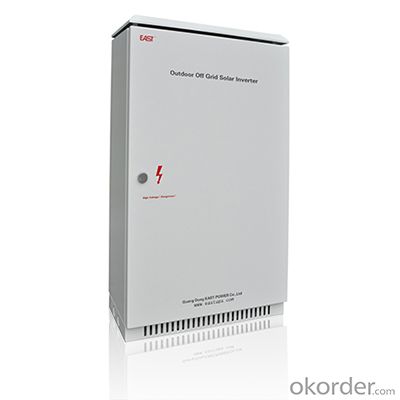

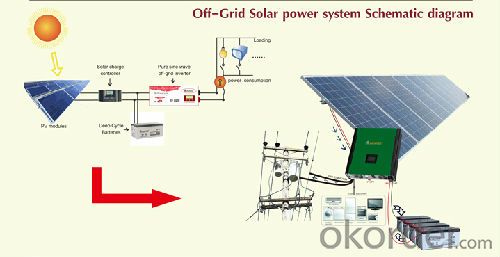
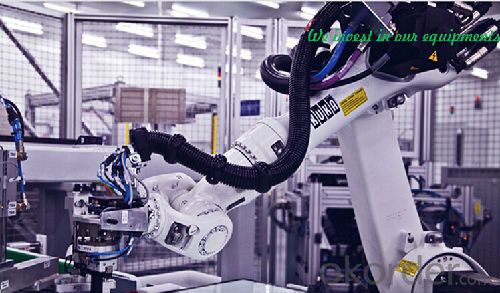
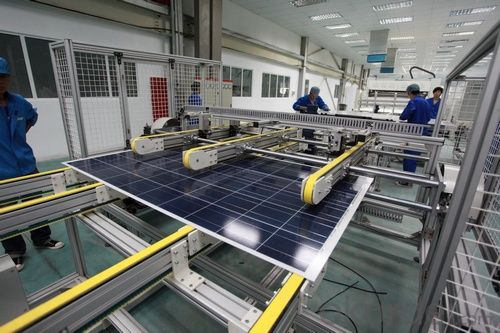
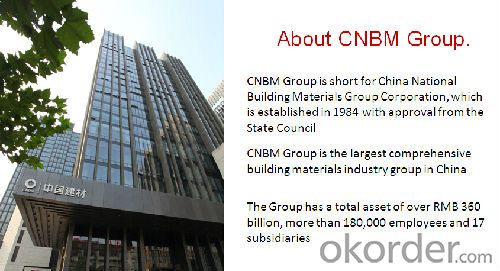
- Q: What is the maximum temperature range for a solar inverter?
- The maximum temperature range for a solar inverter typically varies between -25°C to 60°C (-13°F to 140°F), although it can vary depending on the specific model and manufacturer.
- Q: How does the input current rating affect the performance of a solar inverter?
- The input current rating of a solar inverter affects its performance by determining the maximum amount of current it can handle from the solar panels. If the input current rating is too low, it may limit the amount of power that can be converted and fed into the electrical system. On the other hand, if the input current rating is too high, it may lead to excessive heat generation and potential damage to the inverter. Therefore, selecting an appropriate input current rating is crucial for optimal performance and efficient energy conversion of a solar inverter.
- Q: How does shade affect the performance of a solar inverter?
- Shade significantly impacts the performance of a solar inverter by reducing the overall energy production. When a solar panel is partially shaded, it creates multiple voltage levels throughout the array, leading to a decrease in the overall power output. This shading effect causes the inverter to work inefficiently as it struggles to optimize energy conversion. Consequently, shade can significantly hinder the performance and efficiency of a solar inverter.
- Q: Can a solar inverter be used with different solar panel technologies?
- Yes, a solar inverter can be used with different solar panel technologies as long as the inverter is compatible with the specific voltage and power output of the panels. However, it is important to ensure that the inverter is designed to handle the specific characteristics and requirements of each solar panel technology for optimal performance and efficiency.
- Q: What is the role of a solar inverter in a net metering system?
- The role of a solar inverter in a net metering system is to convert the direct current (DC) produced by the solar panels into alternating current (AC) that can be used to power appliances in a home or business. It also ensures that any excess electricity generated by the solar panels is fed back into the grid, allowing the user to earn credits or be compensated for the excess energy.
- Q: Can a solar inverter be used in a hybrid solar system?
- Yes, a solar inverter can be used in a hybrid solar system. A hybrid solar system combines both solar energy and another source of energy, such as a battery or grid power. The solar inverter is responsible for converting the DC (direct current) power generated by the solar panels into AC (alternating current) power that can be used to power the electrical devices in a home or business. In a hybrid solar system, the solar inverter can still perform this function, allowing the system to utilize solar energy while also being able to draw power from other sources when needed.
- Q: How does a solar inverter protect against overvoltage?
- A solar inverter protects against overvoltage by continuously monitoring the voltage levels of the solar panels. If the voltage exceeds a predetermined threshold, the inverter immediately reduces the power output or shuts down to prevent damage to the system.
- Q: Can a solar inverter be used with solar-powered water purification systems?
- Yes, a solar inverter can be used with solar-powered water purification systems. A solar inverter is responsible for converting the direct current (DC) power generated by solar panels into the alternating current (AC) power required for most electrical devices. Since water purification systems often require AC power to operate, integrating a solar inverter allows the system to utilize the energy harnessed from solar panels efficiently.
- Q: What is the role of maximum power control in a solar inverter?
- The role of maximum power control in a solar inverter is to optimize the power output of the photovoltaic (PV) system by continuously tracking the maximum power point (MPP) of the solar panels. This control mechanism ensures that the inverter extracts the maximum amount of energy from the PV array, despite variations in solar irradiation and temperature. By constantly adjusting the inverter's operating conditions to match the MPP, maximum power control maximizes the overall efficiency and performance of the solar power system.
- Q: Can a solar inverter be used with a solar-powered electric fence system?
- Yes, a solar inverter can be used with a solar-powered electric fence system. The solar inverter is responsible for converting the direct current (DC) generated by the solar panels into alternating current (AC) to power the electric fence system. This allows the solar panels to efficiently charge the battery and power the electric fence, providing a renewable and sustainable energy solution.
Send your message to us
5000W Outdoor Off-Grid Solar Inverter Specially Designed for Outdoor Communication Equipment
- Loading Port:
- China main port
- Payment Terms:
- TT or LC
- Min Order Qty:
- 1 pc
- Supply Capability:
- 1000 pc/month
OKorder Service Pledge
OKorder Financial Service
Similar products
Hot products
Hot Searches
Related keywords
